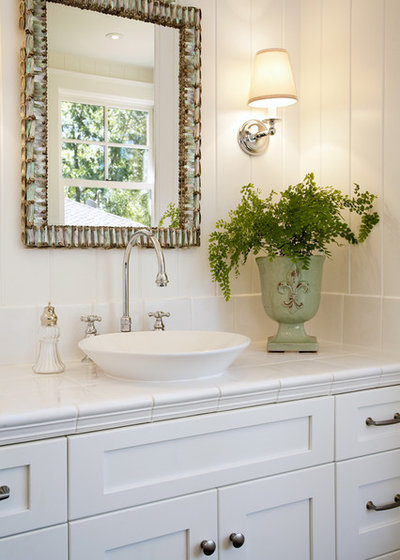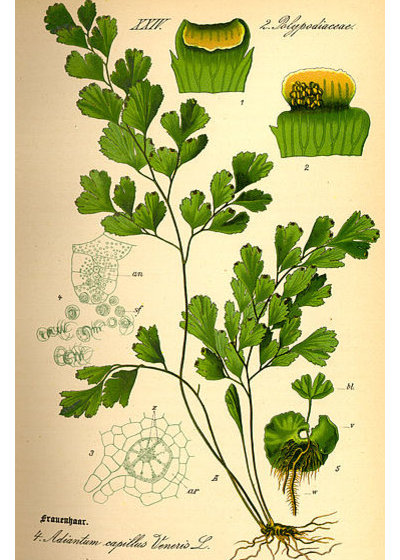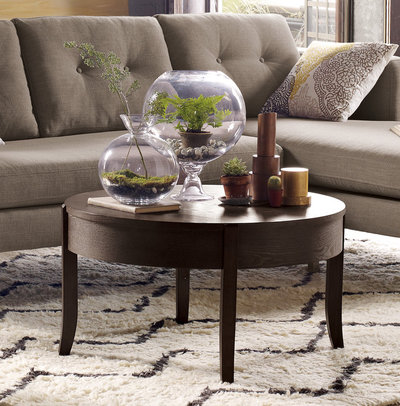Maidenhair ferns are delicate plants with very fine stalks and a lacy appearance, thanks to small leaflets composing the fronds. They require high humidity and have other specific care requirements, but their beauty and elegance may very well steal your heart, making the extra attention well worth it.

Kate Jackson Design
Maidenhair fern can grow to about 3 feet tall in its natural habitat, but varieties produced for houseplants are commonly much smaller.

Julie Williams Design
A countertop location in a bright bathroom may be the perfect humid environment for a maidenhair fern. Bowed fronds make it particularly suited to tall-footed urns, which lend a graceful look as well as keep the fronds from touching the base surface, which can cause damage.

Sally Wheat Interiors
Provide indoor maidenhair ferns with warmth and moisture to keep them active. If the temperature goes lower than 60 degrees Fahrenheit or the plant dries out, it will likely go dormant. (More on what to do about that later.)
While the maidenhair fern on this coffee table looks gorgeous, a placement such as this is recommended only if you live in a humid environment or don't mind misting your plant several times a day.

creative jewish mom.com
Maidenhair ferns grow from rhizomes that spread quickly just under the surface of the soil. The fronds come from brownish-black leaf stalks, which unfold to display their apple-green leaflets.

West Elm
A small potted maidenhair works well on a bed of moist rocks in a footed terrarium (or even a goldfish bowl), which creates an ideal humid environment.

California Home + Design
It's not called maidenhair for nothing. A head-shaped planter is a fun way to spruce up a living space.
 How to care for a maidenhair fern:Temperature:
How to care for a maidenhair fern:Temperature: 60 to 75 degrees Fahrenheit (16 to 24 degrees Celsius), though above 70 degrees is best. This plant is especially sensitive to cold drafts.
Light: Shade or a moderately lit spot. Intense bright light is not preferred; direct sunlight will burn the delicate plant.
Water: Keep the soil evenly moist year-round. If you allow the soil to dry out, even for a short period, the foliage will quickly turn brown, and the plant will appear lifeless. Not all is lost, however; the plant can come back to life if you trim all the brown foliage and resume care as specified. To rescue a plant that hasn't dried out completely, submerge the pot in a bucket of water; keep it submerged until air bubbles stop rising to the surface. This will thoroughly moisten the soil and help keep the plant from going into a dormant stage.
Soil: Use rich, loose, organic compost; half potting mix and half peat moss. Avoid potting mix containing fertilizer, because it can dissolve too fast and burn the delicate fern roots.
Feeding: Feed weekly with a weak liquid fertilizer during the growth season.
Humidity: High humidity is required.
Unless your plant is in a humid bathroom, use a tray of pebbles to keep the humidity elevated. Mist frequently. This is the perfect plant to use in a terrarium or under a cloche (shown here), especially if high humidity isn't practical in your house.
Repotting: Potting in a small container won't harm the plant, but keep an eye on the root growth. When the roots fill the container, it's time to repot.
If your plant is happy
, repotting may be
necessary
only one to two times a year, depending on the pot size and growth rate. Maidenhair can be divided by separating the rhizomes during repotting to make more plants. Each rhizome section needs only a few leaf stalks to grow into a new plant.
Toxicity: Nontoxic.





